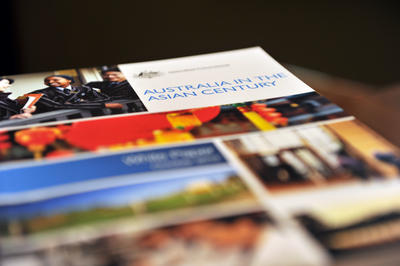The shifts in the structure of global economic power that are under way are bigger shifts in the locus of global output than those recorded after the industrial revolution, and they are taking place in much shorter timeframes. As Gillard said when she launched the review, ‘Australia hasn’t been here before’ and Asia’s re-emergence in the 21st century as a major locus of world economic power has produced huge changes of ‘type, not degree’.
The impact of Asia’s rise is not, of course, unique to Australia although Australia’s geo-economic location in the region means that it is at the frontline of change. In Tokyo, Singapore, and Beijing (at its vortex) policy leaders face the same challenge, albeit from different perspectives.
The first step was to acknowledge, as Gillard did when she set out the task in September last year, that the response to these changes, so far, had been piecemeal and ad hoc, and that an underlying premise had been that the changes in our strategic circumstance are matters of degree, not substance. This was a bold move. It took on up-front the deep and inevitable resistance to change, especially in those parts of the bureaucracy and the political system who were the custodians of the status quo policies.
Australian government, and those in other countries too, have not been willing to accept, and to face front-on, the reality of the changes we face in our region. In Australia, Gillard changed the game. Her call for a rethink and a new strategy on Australia’s engagement with Asia provided the reference point needed for the White Paper Task Force and its Advisory Committee to have any chance of a bold shift in policy thinking and direction.
How has the White Paper measured up to the task?
In parts it is inspired, accepting that the changes that must be wrought in the Australian economy and society to manage a world in which the new Asian powers will be a dominant force in the global order is a task beyond the capacity of governments or policy alone. It requires participation across the community — of business, the educational institutions, community leaders, unions — and nothing less than a change in national mindset. There is no quick policy fix to this problem. It is a patient long term task on which a national consensus has to be forged, and an ongoing national conversation must be had.
There are bold commitments to build Asia-relevant capabilities and literacy and open the door on Asia in a way that some have hoped for, but has not been tried before.
There is acceptance of the priority of building deeper, more comprehensive relationships with the three big new emerging powers in the region — China, Indonesia and India. This includes the security, as well as the economic dimension, of these relationships. One danger is that the policy establishment resists these initiatives and rejects their boldness. There is some evidence of a sub-text in the argument of inclinations towards the self-satisfied notion that getting the relationship with China, Indonesia and India right might be just a matter of tweaking established arrangements at the edges. It is not. It’s a far bolder ambition, as the headlines in the White Paper suggest, and will require energies and talents that are not confined to government.
For the rest, there is a proper emphasis on getting economic and social policies right at home as the core in managing Australia’s relationships with Asia well, both taking advantage of the opportunities and alleviating the risks.
In this week’s lead essay, Andrew MacIntyre provides his assessment of the White Paper, arguing that the ‘mix of messages and initiatives is about right’.
MacIntyre says the White Paper ‘lays out an array of Asia-specific national preparedness and linkage-building initiatives’ and notes that ‘the list is impressive, ranging across all sectors of the community’. One important example of those initiatives, he points out, is to ‘push to have one third of board members of publicly listed companies and national government bodies as well as one third of the Australian public service leadership with deep experience in and knowledge of Asia’.
Prime Minister Gillard has provided Australia with a roadmap for making the most of, and contributing positively to, the Asian Century, and as MacIntyre says, that roadmap will doubtless evolve in the years ahead. That is the nature of the exercise, as the White Paper sets directions that will require elaboration and much careful work to deliver over, in some cases, many years.
Australia finds itself in the right place at the right time ‘but geography does not determine how successfully we will manage this’, MacIntyre cautions. ‘There is too much to gain — as well as a great deal to lose — to continue simply with business as usual.’
Shiro Armstrong is Editor of the East Asia Forum.

